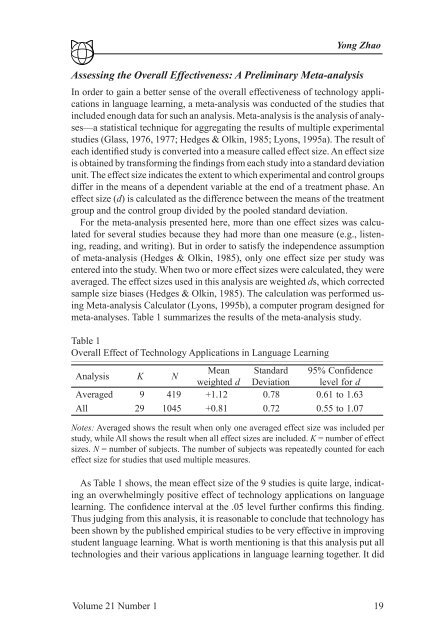Recent Developments in Technology and Language ... - CALICO
Recent Developments in Technology and Language ... - CALICO
Recent Developments in Technology and Language ... - CALICO
Create successful ePaper yourself
Turn your PDF publications into a flip-book with our unique Google optimized e-Paper software.
Yong Zhao<br />
Assess<strong>in</strong>g the Overall Effectiveness: A Prelim<strong>in</strong>ary Meta-analysis<br />
In order to ga<strong>in</strong> a better sense of the overall effectiveness of technology applications<br />
<strong>in</strong> language learn<strong>in</strong>g, a meta-analysis was conducted of the studies that<br />
<strong>in</strong>cluded enough data for such an analysis. Meta-analysis is the analysis of analyses—a<br />
statistical technique for aggregat<strong>in</strong>g the results of multiple experimental<br />
studies (Glass, 19 6, 19 ; Hedges & Olk<strong>in</strong>, 19 5; Lyons, 1995a). The result of<br />
each identified study is converted <strong>in</strong>to a measure called effect size. An effect size<br />
is obta<strong>in</strong>ed by transform<strong>in</strong>g the f<strong>in</strong>d<strong>in</strong>gs from each study <strong>in</strong>to a st<strong>and</strong>ard deviation<br />
unit. The effect size <strong>in</strong>dicates the extent to which experimental <strong>and</strong> control groups<br />
differ <strong>in</strong> the means of a dependent variable at the end of a treatment phase. An<br />
effect size (d) is calculated as the difference between the means of the treatment<br />
group <strong>and</strong> the control group divided by the pooled st<strong>and</strong>ard deviation.<br />
For the meta-analysis presented here, more than one effect sizes was calculated<br />
for several studies because they had more than one measure (e.g., listen<strong>in</strong>g,<br />
read<strong>in</strong>g, <strong>and</strong> writ<strong>in</strong>g). But <strong>in</strong> order to satisfy the <strong>in</strong>dependence assumption<br />
of meta-analysis (Hedges & Olk<strong>in</strong>, 19 5), only one effect size per study was<br />
entered <strong>in</strong>to the study. When two or more effect sizes were calculated, they were<br />
averaged. The effect sizes used <strong>in</strong> this analysis are weighted ds, which corrected<br />
sample size biases (Hedges & Olk<strong>in</strong>, 19 5). The calculation was performed us<strong>in</strong>g<br />
Meta-analysis Calculator (Lyons, 1995b), a computer program designed for<br />
meta-analyses. Table 1 summarizes the results of the meta-analysis study.<br />
Table 1<br />
Overall Effect of <strong>Technology</strong> Applications <strong>in</strong> <strong>Language</strong> Learn<strong>in</strong>g<br />
Analysis K N<br />
Mean<br />
weighted d<br />
St<strong>and</strong>ard<br />
Deviation<br />
95%<br />
Confidence<br />
level for<br />
d<br />
Averaged 9 419 + 1.<br />
12<br />
0. 0.<br />
61<br />
to<br />
1.<br />
63<br />
All 29 1045 + 0.<br />
1 0. 2 0.<br />
55<br />
to<br />
1.<br />
0<br />
Notes: Averaged shows the result when only one averaged effect size was <strong>in</strong>cluded per<br />
study, while All shows the result when all effect sizes are <strong>in</strong>cluded. K = number of effect<br />
sizes. N = number of subjects. The number of subjects was repeatedly counted for each<br />
effect size for studies that used multiple measures.<br />
As Table 1 shows, the mean effect size of the 9 studies is quite large, <strong>in</strong>dicat<strong>in</strong>g<br />
an overwhelm<strong>in</strong>gly positive effect of technology applications on language<br />
learn<strong>in</strong>g. The confidence <strong>in</strong>terval at the .05 level further confirms this f<strong>in</strong>d<strong>in</strong>g.<br />
Thus judg<strong>in</strong>g from this analysis, it is reasonable to conclude that technology has<br />
been shown by the published empirical studies to be very effective <strong>in</strong> improv<strong>in</strong>g<br />
student language learn<strong>in</strong>g. What is worth mention<strong>in</strong>g is that this analysis put all<br />
technologies <strong>and</strong> their various applications <strong>in</strong> language learn<strong>in</strong>g together. It did<br />
Volume 21 Number 1 19
















